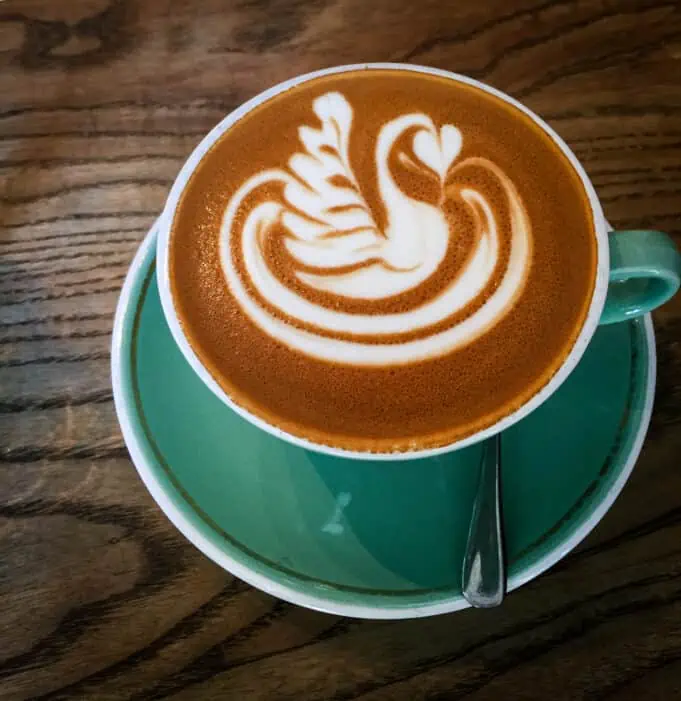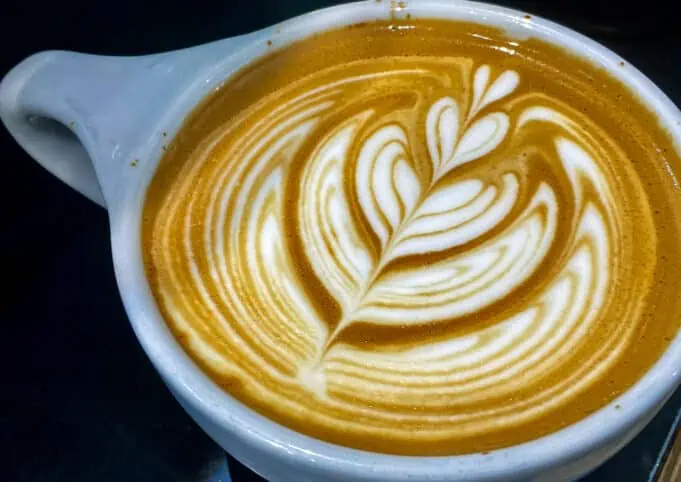Here’s 7 quick tips and some video resources that will help you make latte art or make better latte art if you’re looking to refine the (sometimes tricky) process.
Latte art can be both thrilling and exasperating.
Learning how to pour latte art can take months and maybe even years to perfect. Thankfully, with YouTube videos and years of internet resources figuring how to improve or even begin has become easier. There’s a lot of content out there.
I’ve been a would-be “home barista” — or at least an aspiring one — for about eighteen years now. With a workhouse HX espresso machine, I’ve enjoyed pouring shots for family and friends, and myself as well. But learning how to pour latte art is a whole new ball game. It really challenged me. And, ultimately, I actually had fun in the process.
Think of latte art sort of like that first year calculus or statistics class. You know the subject matter is important, and will better prepare your skillset for what’s to come. Yet, you sure as heck do not want to be there every day, never mind the painstaking hours of homework! Some day in the journey something magical happens. Things click. You start to get it. All of a sudden what seemed like gobbledygook has meaning. You’ve made it!
Okay, that analogy might be a bit of a stretch. However, the principles apply. Put in the hard work and the hours, and you’ll eventually be rewarded and feel great about your achievement.
Without further ado, here’s some quick tips and things I learned along the way in my quest to learn how to make (better) latte art.
7 Tips: How to make better latte art

1. Milk texture is essential
Start with your milk. It has to be near perfect or you’ll be handicapping your entire latte art experience. Be careful not to aerate too much — letting in too much air. Aim to let in air with the frothing tip at the surface of the milk for only 1-2 seconds. Then move it beneath the surface to finish steaming with a nice vortex until the pitcher is hot to touch.
The goal: glossy white milk that looks like paint. If you see clumps of milk when pouring you’re again seeing a clue that you’ve let in too much air. Frothed milk is suitable for cappuccinos, but for lattes you want beautiful, smooth flowing glossy white milk that will help you create beautiful designs.
2. Avoid too much surface tension
If you’ve watched latte art tutorials and how-to blogs and articles, you’ll know there’s essentially two phases to the pour: (1) creating a base by pouring milk deep into the espresso shot; and (2) next when you move the pitcher close to the surface to create the design itself.
Pouring too long or too strongly in part 1 to create the base can create too much surface tension.
This means when you try to pour your design there will be what seems like “push back” from the existing milk, making it hard for your design to flow or expand as needed.
So if you’re having problems with small designs or even getting the art started keep an eye on the surface tension and keep it to a minimum by not overpouring the base. Hint: this may also help you achieve higher contrast.
3. Pour into a second pitcher
Here’s a bit of a cheat code. If you continually hit your head against the wall and can’t seem to get the right milk texture no matter what you do, try pouring the milk into a second pitcher.
For example, if you’re frothing milk in a 6.8oz pitcher (which can be tricky when using powerful espresso machine steam wands), when finished pour that into a 12oz pitcher.
Transferring the milk between pitchers will help improve the milk texture and consistency and potentially reduce bubbles and clumping. The downside: having to do a little extra cleanup. While learning and practicing, the additional effort might be worth it.
4. Design phase: Be aggressive with the cup angle and keep pitcher close to the surface
One key breakthrough I experience when trying over and over to get good designs on a repeatable basis was to be aggressive with both the cup angle and pitcher proximity. Cup your glass or cup at a 45-degree angle. Really make sure it’s tilted quite a bit.
Next, move the tips of the pitcher ever so close to the surface near center to begin the pour. Again, also be aggressive with the pour here. If you go too light the design will not have enough momentum or force to create a pattern. Practice and time will help you develop a sense of the right technique here. But like learning to ride a bike, once you get it, you’ll never forget it.
5. Try using a larger cup
Pouring art into smaller cups tends to be more challenging. Drinks like Cortados and Flat Whites can be tricky because you have less time to pour your art. An 8- or 10-ounce Latte buys more time, and gives you a better probability for success when learning. Simple then, try a larger cup.
After you’ve mastered the larger pours, then try the challenging 4- and 6-ounce pours. Same applies too when steaming milk. It’s generally easier when working with larger pitchers.
6. Practice, watch YouTube videos, and practice some more
YouTube is definitely your friend. When it comes to latte art there’s an eternal spring of content.
I say choose a few of your favorite presenters or personalities and watch them over and over again. Especially pay attention to the key moments when creating the base and then when beginning the actual art design.
Start with the classic latte heart. Then evolve from there once you’ve nailed the basics.
Oh, keep in mind seasoned baristas make this stuff look effortless. That’s because they’re experts and many do this for a living and have, like a professional athlete, elevated their game to the absolute top of the class. Please don’t expect those sorts of results immediately. Patience and practice are key.
Espresso on Stark Insider
- First Look: Breville Barista Touch Impress Espresso Machine – an automated barista for the home
- Tested: Can a dosing funnel improve your espresso workflow?
- Review: Normcore Espresso Tamping Mat
- Jura Z10 Review: The absolute best super-automatic espresso machine for home or office
- Home Espresso: A Cortado in a Gibraltar glass is pure luxury
7. Practice like a conductor
Here’s a personal one. I’ve never heard this mentioned before, but miming the process with just your hands can help you develop muscle memory. It’s sort of like air guitar!
Next time you watch a YouTube video play along by using your hands to follow the instructor or barista. It might feel silly, but it can help you reinforce the timing and fluidity needed.
You can even do it when you’re just standing around somewhere waiting for someone. Go ahead. Pretend you’re conducting your own private latte art symphony. Others around might think your crazy, but why not develop the right mind set whenever you can? After all who doesn’t like performing (or at least attempting) a grand latte art performance?!
Some favorite YouTube latte art videos for your consideration
Everyone will have their own favorites. We all tend to respond or click with different instructors and personalities. Below are a few picks for my favorite how-to latte art and milk steaming videos.
Note that technique can differ slightly. For instance, some will seamlessly move from the base preparation to the design pour without any delay while others will take a pause, or even distinctly create two phases. There’s plenty of tutorials and best practices, but it’s up to you to synthesize this information and find your own way to achieve greatness.
Latte Art for Beginners: How To Pour a Heart
Everything You Need To Know To Steam Great Milk
The Ultimate Guide to Latte Art
Latte Art: Basic Tips & Tricks to Practice at Home
This is a good one by La Marzocco Home that demonstrates how you can inexpensively practice latte art techniques using just water.
Don’t despair — enjoy the journey. The results will come with time and I wish you well in your experimentation and, eventual, triumph.
Happy Espresso!


